Skip to content
Ready to peek into Christmas Past, Texas style? Let me take you on a virtual visit to the George Ranch Historical Park in Richmond where they’ve lassoed a wonderful event to share just that!
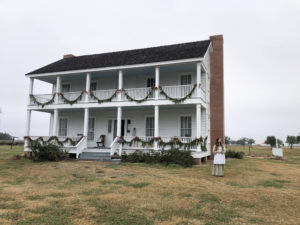
The annual Christmas at the Ranch event was a bit different this year due to additional safety protocols, but the staff couldn’t have created a more welcoming and fascinating day for their guests.
Founded in 1824, the George Ranch showcases the four homes of four generations of this Texas family, and this time of year they’re dressed up for the season.
My first stop was at the visitor center, where I was provided with a map of the ranch and demonstration schedule. The park is laid out in a mile long loop (yes, a MILE), and visitors can ride a tractor pulled tram from one stop to the next. But I highly suggest combining riding and walking when weather permits, to enjoy the natural surroundings.
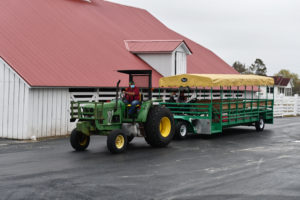
I rode the tram to my first stop, the 1830s Jones Stock Farm dog trot cabin, and was greeted by the volunteers dressed in period costumes. The cabin and buildings are replicas of Henry and Nancy Jones’ homestead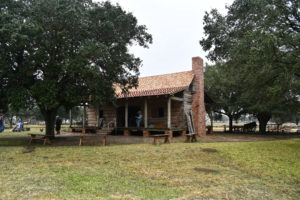 – one of the earliest settlements of Northeast Mexico. Nope, it wasn’t even Texas yet!
– one of the earliest settlements of Northeast Mexico. Nope, it wasn’t even Texas yet!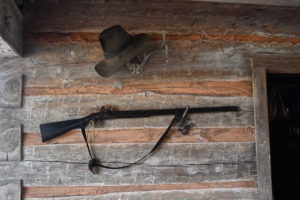
One gentleman shared the background of the family and information about the cabin, and another charmer played beautiful music on his guitar and told a few tall tales that were impossible to resist.
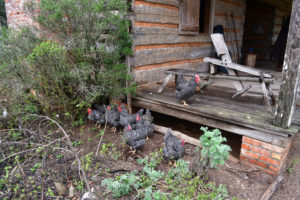
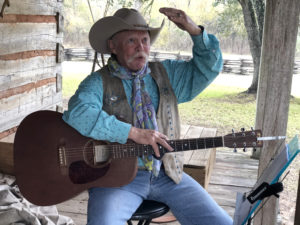
A young woman had the unenviable, sticky task of demonstrating how to clean a deer hide in a yard populated by adorable hens, but managed to do it with a smile while explaining that when the thin hides were worked until thy were translucent, they could be used to cover the cabin windows during the winter months (since glass wouldn’t have been available).
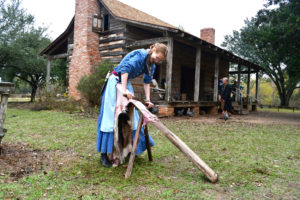
In the breezeway of the dogtrot a young man worked at weaving on a loom, taking breaks to serve visitors Mexican hot cocoa that was brewing over one of the hearth fires – and was a treat on the chilly day.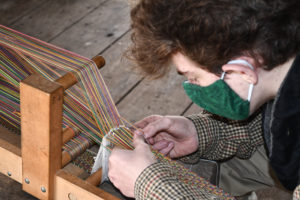
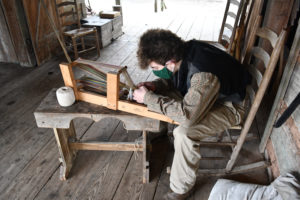
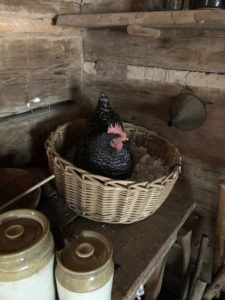
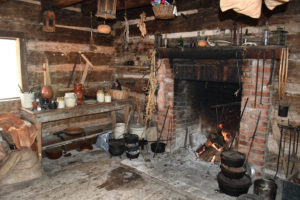
 In the nearby hog pen, one of the volunteers scratched the back of one of the docile 300-pound Berkshire pigs that are part of an initiative to preserve heritage breeds. Seems these fragrant residents are descendants of a rare breed that came to Texas from England in the 1830s. I know people who can’t trace their lineage as well!
In the nearby hog pen, one of the volunteers scratched the back of one of the docile 300-pound Berkshire pigs that are part of an initiative to preserve heritage breeds. Seems these fragrant residents are descendants of a rare breed that came to Texas from England in the 1830s. I know people who can’t trace their lineage as well!
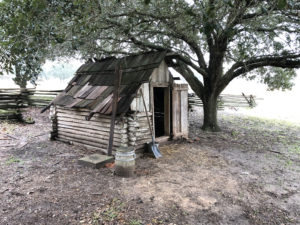 After a quick look at the chicken coop (always interesting to me since gathering the eggs was my job when visiting my grandmother’s farm), smokehouse barn and outdoor kitchen, I worked my way back to the road to hop on the tram again.
After a quick look at the chicken coop (always interesting to me since gathering the eggs was my job when visiting my grandmother’s farm), smokehouse barn and outdoor kitchen, I worked my way back to the road to hop on the tram again.
Next stop: the 1860s Ryon Prairie home – picture perfect with garlands of evergreens draped across the porch rails.
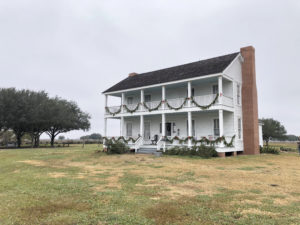
Mary Moore “Polly” Ryon was the oldest of the Jones’ daughters. She inherited th majority of her family’s wealth, and amazingly was on of the largest land holders in the region by age 18! She and her husband William built a cattle ranching empire after the Civil War.
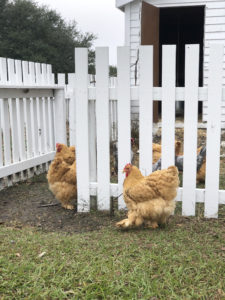
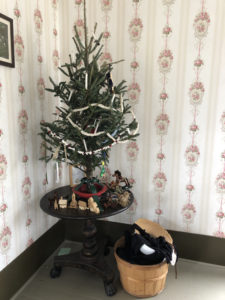 One young woman showed me around the knot garden and chicken coop until it was my turn (social distancing, ya know) to go inside the house.
One young woman showed me around the knot garden and chicken coop until it was my turn (social distancing, ya know) to go inside the house.
Inside two young docents explained the uses of the men’s and women’s parlors, and directed me toward the kitchen where more volunteers were baking cookies for the visitors in a period stove.
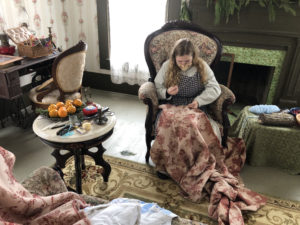
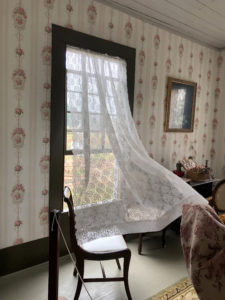
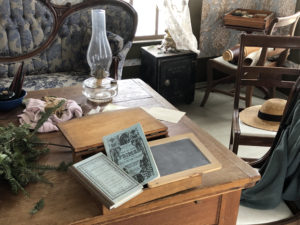
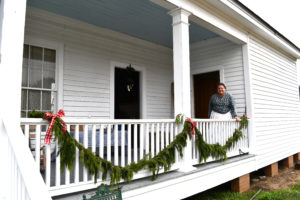
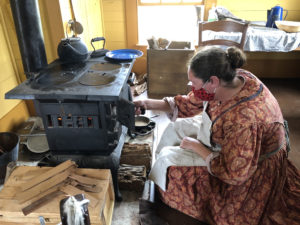
I decided to walk the rest of the property rather than ride the tram since it was a beautiful day and I didn’t see any reason to rush.
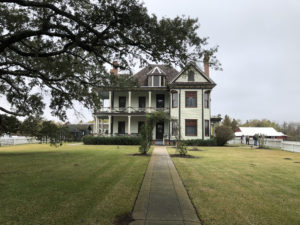
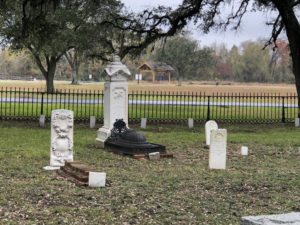 Susan Elizabeth Ryan was Polly’s only surviving child and sole heir of Polly’s estate. She married banker civic leader John Harris Pickens Davis. The Victorian era home sits in a complex that includes a sharecropper’s farm, the family cemetery with graves dating between the 1820s to 1916 and the Oldenberg blacksmith shop. It seemed ironic to me that Polly isn’t in the family cemetery (she’s at Morton Cemetery in Richmond). But the existing monuments are beautiful and well cared for.
Susan Elizabeth Ryan was Polly’s only surviving child and sole heir of Polly’s estate. She married banker civic leader John Harris Pickens Davis. The Victorian era home sits in a complex that includes a sharecropper’s farm, the family cemetery with graves dating between the 1820s to 1916 and the Oldenberg blacksmith shop. It seemed ironic to me that Polly isn’t in the family cemetery (she’s at Morton Cemetery in Richmond). But the existing monuments are beautiful and well cared for. 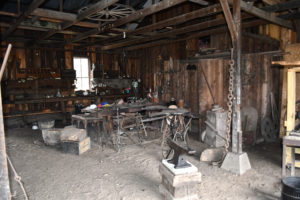
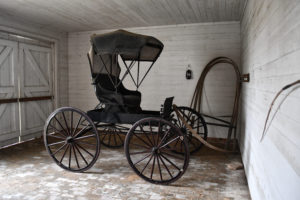 In the blacksmith shop, kids were invited to try their hand at “forging” knives from chunks of clay with rubber mallets.
In the blacksmith shop, kids were invited to try their hand at “forging” knives from chunks of clay with rubber mallets.
In the side yard of the home, a sweet volunteer led visitors in creating Victorian style Christmas ornaments from paper as keepsakes of their visit.
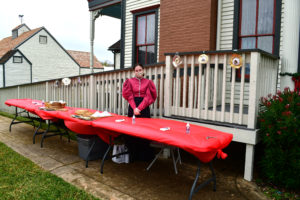
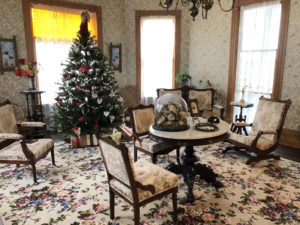
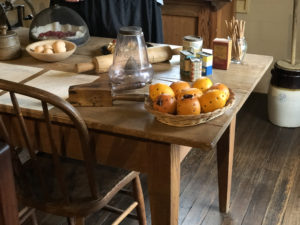
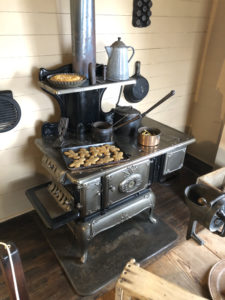

The last home to tour was the 1930s George Ranch House (designed by famous Galveston architect Nicholas Clayton) and complex, where a barbershop quartet was entertaining passersby with Christmas carols.
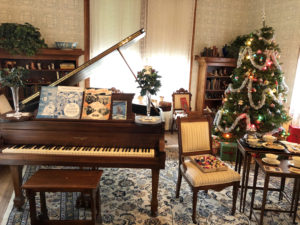
Mamie George and her husband A.P. were the last descendants of the Henry and Nancy Jones family to oversee the ranching operation. Their influence and support is still seen across the community in libraries, schools, the Houston Livestock Show and Rodeo, a community center and countless other contributions. 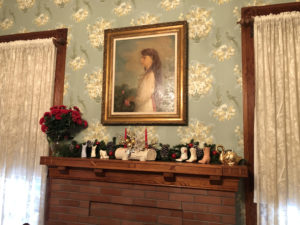
Their home is still decorated with their furnishings, right down to the ornaments on the Christmas tree! I loved Mamie’s collection of ceramic cowboy boots from her travels lined up on the mantle.
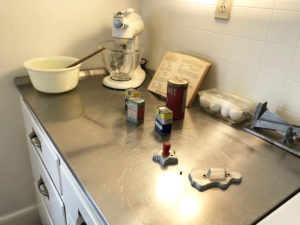
Once all of the home tours were checked off of my list, I headed to the arena and barn area for the cattle working demonstrations.

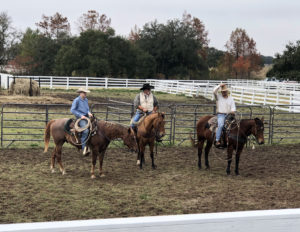
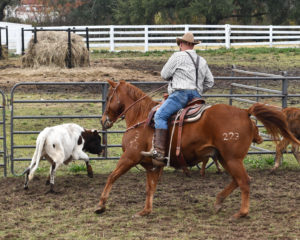
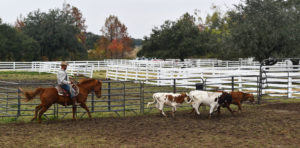
The cowboys demonstrated some basic cutting and lassoing techniques while explaining how and why these things are still down on the working ranch. Afterward, one of the cowboys walked the onlookers over to a dipping vat and related how they were used in the past – and why they aren’t any more (thank heaven!).
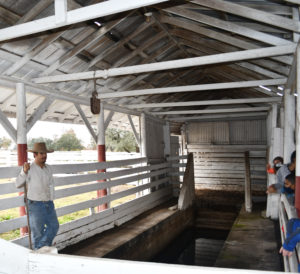
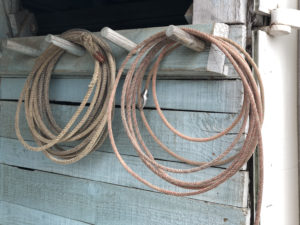
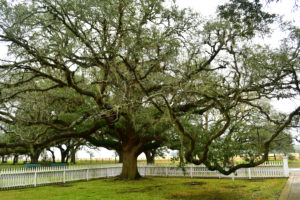

“Run, run, run as fast as you can
You can’t catch me, I’m the gingerbread man!”
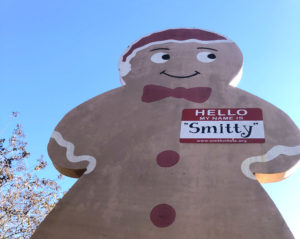
Well, actually it’s pretty easy to catch up with THIS gingerbread man.
In 2006, the organizer of Smithville Texas’ annual Festival of Lights event baked up a delicious plan to take their celebration to the next level – by baking the world’s largest gingerbread cookie!
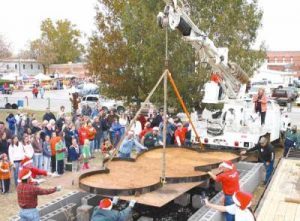 Mixing together 750 pounds of flour, 49 gallons of molasses and 72 dozen (separated!) eggs, they created a Texas-sized gingerbread man. They n immense cookie sheet baked the 1,307 pound fellow on an immense cookie sheet over a dump truck load of charcoal (take THAT Food Network!) and then raised him with a crane to the 65 degree angle required by the folks at Guinness World Records for consideration.
Mixing together 750 pounds of flour, 49 gallons of molasses and 72 dozen (separated!) eggs, they created a Texas-sized gingerbread man. They n immense cookie sheet baked the 1,307 pound fellow on an immense cookie sheet over a dump truck load of charcoal (take THAT Food Network!) and then raised him with a crane to the 65 degree angle required by the folks at Guinness World Records for consideration.
Phew!
The staff at Guinness officially recognized the spied feat in the 2009 edition of their record book.
 Now . . . how to memorialize the achievement? The Smithville Area Chamber of Commerce and the City of Smithville had the cookie sheet used to bake the gigantic gingerbread man converted into an enormous, 20-foot tall metal replica of the cookie, and the townspeople affectionately dubbed him “Smitty.”
Now . . . how to memorialize the achievement? The Smithville Area Chamber of Commerce and the City of Smithville had the cookie sheet used to bake the gigantic gingerbread man converted into an enormous, 20-foot tall metal replica of the cookie, and the townspeople affectionately dubbed him “Smitty.”
He stands in the town park making sure visitors can celebrate the spirit of Christmas all year long. Heads up, though, even though he towers over the park, he’s a bit hidden from the street by the trees in the park so you’ll have to get out of you car to see him in all his gingerbread-y glory.
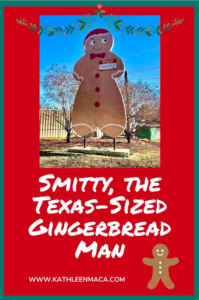
 – one of the earliest settlements of Northeast Mexico. Nope, it wasn’t even Texas yet!
– one of the earliest settlements of Northeast Mexico. Nope, it wasn’t even Texas yet!


 In the nearby hog pen, one of the volunteers scratched the back of one of the docile 300-pound Berkshire pigs that are part of an initiative to preserve heritage breeds. Seems these fragrant residents are descendants of a rare breed that came to Texas from England in the 1830s. I know people who can’t trace their lineage as well!
In the nearby hog pen, one of the volunteers scratched the back of one of the docile 300-pound Berkshire pigs that are part of an initiative to preserve heritage breeds. Seems these fragrant residents are descendants of a rare breed that came to Texas from England in the 1830s. I know people who can’t trace their lineage as well! After a quick look at the chicken coop (always interesting to me since gathering the eggs was my job when visiting my grandmother’s farm), smokehouse barn and outdoor kitchen, I worked my way back to the road to hop on the tram again.
After a quick look at the chicken coop (always interesting to me since gathering the eggs was my job when visiting my grandmother’s farm), smokehouse barn and outdoor kitchen, I worked my way back to the road to hop on the tram again.
 One young woman showed me around the knot garden and chicken coop until it was my turn (social distancing, ya know) to go inside the house.
One young woman showed me around the knot garden and chicken coop until it was my turn (social distancing, ya know) to go inside the house. Susan Elizabeth Ryan was Polly’s only surviving child and sole heir of Polly’s estate. She married banker civic leader John Harris Pickens Davis. The Victorian era home sits in a complex that includes a sharecropper’s farm, the family cemetery with graves dating between the 1820s to 1916 and the Oldenberg blacksmith shop. It seemed ironic to me that Polly isn’t in the family cemetery (she’s at Morton Cemetery in Richmond). But the existing monuments are beautiful and well cared for.
Susan Elizabeth Ryan was Polly’s only surviving child and sole heir of Polly’s estate. She married banker civic leader John Harris Pickens Davis. The Victorian era home sits in a complex that includes a sharecropper’s farm, the family cemetery with graves dating between the 1820s to 1916 and the Oldenberg blacksmith shop. It seemed ironic to me that Polly isn’t in the family cemetery (she’s at Morton Cemetery in Richmond). But the existing monuments are beautiful and well cared for. 
 In the blacksmith shop, kids were invited to try their hand at “forging” knives from chunks of clay with rubber mallets.
In the blacksmith shop, kids were invited to try their hand at “forging” knives from chunks of clay with rubber mallets.

































